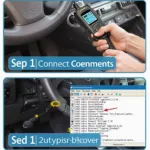Understanding the subaru oxygen sensor cycle obd2 is crucial for maintaining your Subaru’s performance and fuel efficiency. A faulty oxygen sensor can lead to increased emissions, poor fuel economy, and even damage to your catalytic converter. This article will delve into the intricacies of the oxygen sensor cycle, how it relates to OBD2 diagnostics, and provide valuable insights for Subaru owners.
Decoding the Subaru Oxygen Sensor Cycle
The oxygen sensor, also known as the O2 sensor, is a vital component of your Subaru’s emissions control system. It constantly monitors the exhaust gases to determine the air/fuel ratio. This information is then sent to the Engine Control Unit (ECU), which adjusts the fuel injection accordingly. A properly functioning oxygen sensor cycles between rich and lean conditions, generating a fluctuating voltage signal. This “cycling” is a key indicator of a healthy sensor. A slow or stagnant sensor can indicate a problem. You can use an obd2 subaru scanner to check for related trouble codes.
How the Oxygen Sensor Works
The oxygen sensor measures the difference in oxygen levels between the exhaust gases and the ambient air. When the exhaust is rich (too much fuel), the sensor generates a high voltage signal. Conversely, when the exhaust is lean (too much air), the sensor generates a low voltage signal. This constant feedback loop allows the ECU to maintain the optimal air/fuel ratio for efficient combustion and reduced emissions. This is essential for passing an obd2 smog check california.
Diagnosing Oxygen Sensor Issues with OBD2
OBD2 scanners provide a powerful tool for diagnosing oxygen sensor problems in your Subaru. By reading the sensor’s voltage and comparing it to the expected values, you can quickly identify potential issues. Common OBD2 codes related to oxygen sensors include P0130 (Oxygen Sensor Circuit Malfunction), P0131 (Oxygen Sensor Circuit Low Voltage), and P0132 (Oxygen Sensor Circuit High Voltage). Understanding these codes and using an OBD2 scanner can save you time and money on repairs. If you find your subaru obd2 catalyst not ready, an oxygen sensor issue could be the culprit.
Interpreting OBD2 Data
Interpreting OBD2 data requires some understanding of the oxygen sensor cycle. A healthy sensor should cycle between 0.1 and 0.9 volts several times per second. A slow cycle or a sensor stuck at a high or low voltage indicates a problem. It is important to consult your Subaru’s specific repair manual for the correct voltage ranges and diagnostic procedures. Knowing how to use your subaru obd2 port pinout will also be useful for advanced diagnostics.
Common Subaru Oxygen Sensor Problems
Several factors can contribute to oxygen sensor problems in Subarus. These include:
- Aging: Oxygen sensors have a limited lifespan and typically need to be replaced every 60,000 to 90,000 miles.
- Contamination: Exposure to contaminants like fuel additives, oil, and coolant can damage the sensor.
- Wiring Issues: Damaged or corroded wiring can disrupt the sensor’s signal.
- Exhaust Leaks: Exhaust leaks can introduce fresh air into the exhaust stream, affecting the sensor’s readings.
What if the code doesn’t clear after replacing the sensor?
Sometimes, even after replacing a faulty oxygen sensor, the OBD2 code might not clear immediately. You may need to drive around to clear code on obd2. This allows the ECU enough time to relearn the new sensor’s readings and clear the code.
Quote from John Smith, Senior Automotive Technician: “A failing oxygen sensor can significantly impact your Subaru’s performance and fuel economy. Regular checks with an OBD2 scanner are essential for early detection and prevention of more serious problems.”
Conclusion
Understanding the subaru oxygen sensor cycle obd2 is essential for maintaining your vehicle’s health. Regularly checking your oxygen sensor with an OBD2 scanner can help you identify potential problems early on and prevent costly repairs. Remember, a properly functioning oxygen sensor is crucial for optimal performance, fuel efficiency, and reduced emissions.
Quote from Maria Garcia, Certified Subaru Mechanic: “Don’t ignore oxygen sensor codes. They can lead to bigger issues down the line. A simple OBD2 scan can save you a lot of hassle.”
FAQ
- How often should I check my oxygen sensor?
- What are the symptoms of a bad oxygen sensor?
- Can I replace an oxygen sensor myself?
- How much does it cost to replace an oxygen sensor?
- What are the most common OBD2 codes related to oxygen sensors?
- How do I interpret the voltage readings from my oxygen sensor?
- Can a bad oxygen sensor damage my catalytic converter?
Situations for Oxygen sensor problems:
- Check Engine Light is on.
- Poor fuel economy.
- Rough idling.
- Failed emissions test.
- Hesitation or stumbling during acceleration.
Related Articles:
- OBD2 Trouble Codes
- Catalytic Converter Problems
- Subaru Maintenance Schedule
Need Help?
Contact us via WhatsApp: +1(641)206-8880, Email: [email protected] or visit us at 789 Elm Street, San Francisco, CA 94102, USA. Our customer support team is available 24/7.
